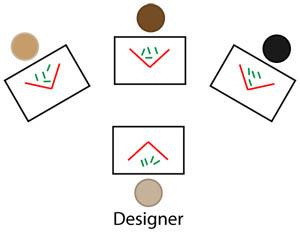Stick images
This task requires learners to explain and help others, asking and answering questions.
Problem
You need to be in a team of four for this task. The idea is to complete the challenge yourself but with support and advice from other members of your team.
A nearby adult can assess how well the team is good at:
- helping others to do things for themselves
- responding to the needs of others - everybody helps everybody
- explaining by telling how.

As you see above, you need to arrange the desks and some props so that everyone can see everyone else but no one can see what anyone else is building. One possibility is for the designer to face the other three team members and make the design inside a box whilst team members try to recreate the design behind books or folders used as screens.
Choose someone in the group to be the designer.
Getting Started
Do you know anything about the total number of lolly sticks the designer has used?
You might find it useful to ask questions which include some of these words.
Student Solutions
Vicente from St Matthew's School wrote;
I am the recource manager and my friend Robert is understanding coordinator and Elijah is the facilator and we work excellently in a team.
Thank you for that Vincente, I imagine that when classes or groups have used this activity then there did not seem to be much to write about from a pupil's point of view. However, we are always happy to hear from children or teachers about how our activities work. Don't worry if you haven't got a 'solution' as such.
Teachers' Resources
Why do this problem?
This task focuses on the creating of shapes and patterns using line segments and the emphasis is on using accurate mathematical language to describe position and orientation. The learners need to listen carefully to follow the instructions they are given or explain clearly and precisely what they do with the lolly sticks.
Possible approach
When teams have finished working on the task it is important that they spend time discussing in groups, and then as a whole class, how well they worked as a team. They can consider what they have learned from the experience and what they would do differently next time, particularly in terms of how to ask questions and answer them effectively. Your own observations, as well as those of observers, might inform the discussions.
